Advertisements
Advertisements
Question
The image obtained while finding the focal length of convex lens is ....................
Options
a) a real and erect.
b) virtual and erect.
c) real and inverted.
d) virtual and inverted.
Solution
c) real and inverted.
APPEARS IN
RELATED QUESTIONS
An object of height 2.5 cm is placed at a distance of 15 cm from the optical centre 'O' of a convex lens of focal length 10 cm. Draw a ray diagram to find the position and size of the image formed. Mark optical 'O', principal focus F and height of the image on the diagram.
"A convex lens can form a magnified erect as well as magnified inverted image of an object placed in front of it." Draw ray diagram to justify this statement stating the position of the object with respect to the lens in each case.
Which of the following lenses would you prefer to use while reading small letters found in a dictionary?
Write one condition where it does not bend when entering a medium of different optical density.
An object AB is placed between O and F1 on the principal axis of a converging lens as shown in the diagram.
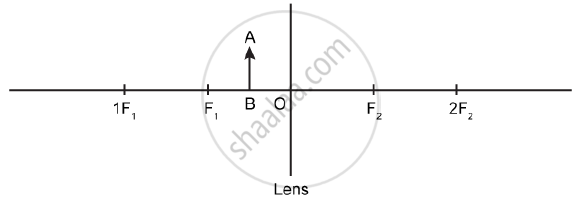
Copy the diagram and by using three standard rays starting from point A, obtain an image of the object AB.
A beam of light travelling in a rectangular glass slab emerges into air. Draw a ray-diagram indicating the change in its path.
A ray of light travelling in water emerges into air. Draw a ray-diagram indicating the change in its path.
A ray of light travelling in air is incident on a parallel-sided glass slab (or rectangular glass slab). Draw a ray-diagram indicating the change in its path in glass.
Where should an object be placed in order to use a convex lens as a magnifying glass?
Where should an object be placed in front of a convex lens so as to obtain its virtual, erect and magnified image?
Where should an object be placed in front of a convex lens so as to obtain its real, inverted and magnified image?
For what position of an object a real, diminished image is formed by a convex lens?
Fill in the following blank with suitable word:
Parallel rays of light are refracted by a convex lens to a point called the ........
What is a lens?
Describe with the help of a ray diagram the nature, size and position of the image formed when an object is placed in front of a convex lens between focus and optical centre. State three characteristics of the image formed.
An object is placed at a distance equal to 2f in front of a convex lens. Draw a labelled ray diagram to show the formation of image. State two characteristics of the image formed.
Describe with the help of a ray-diagram, the size, nature and position of the image formed by a convex lens when an object is placed beyond 2f in front of the lens.
What type of lens is shown in the diagram on the right? What will happen to the parallel rays of light? Show by completing the ray diagram.
A convex lens has a focal length of 10 cm. At which of the following position should an object be placed so that this convex lens may act as a magnifying glass?
(a) 15 cm
(b) 7 cm
(c) 20 cm
(d) 25 cm
Find the position and nature of the image of an object 5 cm high and 10 cm in front of a convex lens of focal length 6 cm.
If the object is moved to a point only 3 cm away from the lens, what is the new position, height and nature of the image?
A student did an experiment with a convex lens. He put an object at different distances 25 cm, 30 cm, 40 cm, 60 cm and 120 cm from the lens. In each case he measured the distance of the image from the lens. His results were 100 cm, 24 cm, 60 cm, 30 cm and 40 cm, respectively. Unfortunately his results are written in wrong order.
Rewrite the image distances in the correct order.
A beam of parallel light rays is incident through the holes on one side of a box and emerges out through the holes on its opposite side as shown in the diagram below:
Which of the following could be inside the box?
(a) a rectangular glass block
(b) a concave lens
(c) a convex lens
(d) a glass prism
Study the diagram below.
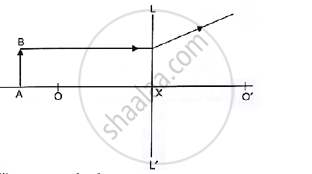
what are the points O, O’ called?
A converging lens forms the image of an object placed in front of it, beyond 2F2 of the lens. Draw a ray diagram to show the formation of the image.
A lens forms an inverted image of an object. Name the kind of lens.
A convex lens has a divergent action and a concave lens has a convergent action.
When you focus the image of a distant flag, whose shape is given below, on a screen using a convex lens, the shape of the image as it appears on the screen is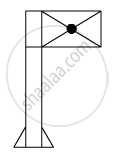
(A)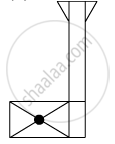
(B)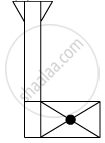
(C)
(D)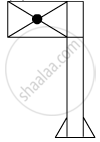
List four properties of the image formed by a convex mirror.
Observe the following figure and answer the questions.
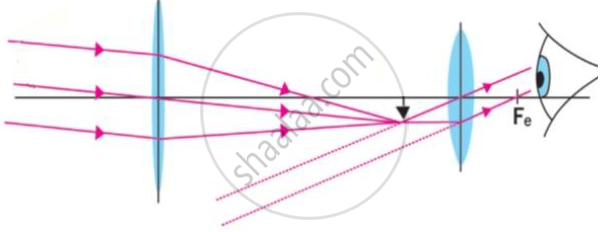
a) Which optical instrument shows arrangement of lenses as shown in the figure?
b) Write in brief the working of this optical instrument.
c) How can we get different magnifications in this optical instrument?
d) Draw the figure again and labelled it properly
In the figure given below L is a convex lens, M is a plane mirror and S is a point source of light. Rays of light from the source S return to their point of origin. Complete the ray diagram to show this. What is the point S called?

A candle is placed between f and 2f a convex lens. Draw a ray diagram showing the position of the image.
Define the terms principal foci and focal lengths as applied to a convex lens, and show them with the help of proper diagrams.
Distinguish between:
Concave lens and Convex Lens
Distinguish between Concave lens and Convex Lens.
Distinguish between Concave lens and Convex Lens.
